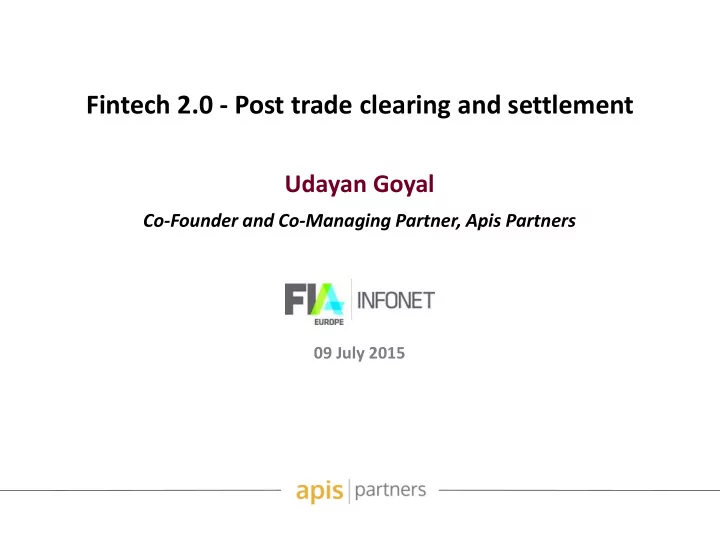

Fintech 2.0 - Post trade clearing and settlement Udayan Goyal Co-Founder and Co-Managing Partner, Apis Partners 09 July 2015 Cover TBU 1
What is Fintech? Redesigned Financial Services for a new competitive environment “everything” as a service high focus on focus on transaction low customer products and costs transaction transactions experience costs capital markets & trading payments insurance & risk capital markets & insurance & risk wealth & asset management trading management management platforms & api s wealth & asset retail banking & business & corporate payments management consumer finance banking retail banking & consumer finance vertically business & corporate loosely-coupled banking integrated but highly opaque networked information information abundance scarcity transparent Industrial economy Information economy 2
These trends are fast becoming permanent features of Financial Services But have been slow to filter into the industry Why? As financial services have been typically characterised by: ‐ High barriers to entry ‐ Very entrenched incumbents ‐ A high degree of regulation Though an increasing number of new (Fintech) ventures that are embracing these trends 3
Moving to Fintech 2.0 Fintech 1.0: New players that took advantage of advances in digital technology and delivered products that were user friendly and less costly to deliver ‐ The market share of these players is growing, but their effect on the overall financial services industry has been minor Fintech 2.0 will be characterised by: ‐ Policy shifts towards open data and APIs ‐ Proliferation of Fintech into middle and back office processes ‐ Fundamental changes to the infrastructure and processes at the core of the financial services Fintech 2.0 represents a broader opportunity to re-engineer the fabric of global financial services 4
Blockchains or ‘distributed ledgers’ - an expected feature of Fintech 2.0 Interesting as a technology rather than a currency Was the first example of functioning blockchain: - a means of decentralised value exchange Clearing house Centralised ledger Distributed ledger 5
The attractive features of distributed ledgers Closed as well as open ‐ Unlike Bitcoin - closed ledgers require participants in the network to be already identified Irrevocable and lower cost transactions ‐ Clearing and settlement near instantaneous, more accurate trade data and reduced settlement risk Guaranteed correct execution ‐ Tamper resistant due to peer to peer architecture; less need for supervision and associated costs Transparency ‐ Accessible historical records of all transactions created for effective auditing by participants, supervisors and regulators Wide applicability ‐ Almost any intangible document / asset can be expressed in code to be used in a distributed ledger ‐ Applicable to any financial instrument: bonds, equities or derivatives 6
Smart contracts are a key application Computer programs that can automatically execute the terms of a contract - relies on computer programs being able to trigger payments 7
Major open source smart contract projects Software that allows anyone A community-driven A platform for securely to build their own secure, project aiming “to executing smart contracts low-cost, data infrastructure decentralise the internet and other types of smart using blockchain and smart and return it to its programs - developed by contract technology democratic roots” Ripple Labs 8
The potential application of distributed ledgers to securities settlement Post trade lifecycle: - Automated - Access to multiple - Increased - Point-to-point - Robust custodian clearing upon users for robust transparency: no settlement, services with smart trade completion monitoring information lowering the cost contracts - asymmetry and risk of eliminating - Real time updates transactions intermediaries on security title - Real time and interests updates on positions of underlying collateral 9
So what? 2 outcomes: Total disruption All market participants have direct access to a decentralised securities depositary: - Access to the exchange and to post-trade infrastructure of clearing and settlement OR Integration of distributed ledger tech into the post-trade ecosystem Custodians or settlement infrastructures use it to record ownership trades between them - Investors required to use a custodian to have access to the market - Ledger accessible to authorised market participants only 10
Fintech companies already working in the space A smart contracts platform Technology company whose that democratises access to mission is to reduce financial markets settlement latency and counterparty risk - Peer-to-peer contract creation and settlement - Uses distributed ledgers to track and settle both - Cleared on the Bitcoin digital and mainstream blockchain financial assets - No trusted intermediary - Will admit creditworthy required (agreed and vetted) - No central custodial risk members to trade between themselves 11
Why is post-trade ripe for change from the status quo? Has been traditionally dominated by expensive and proprietary technology, and inefficient manual processes Forces of change: ‐ Greater regulation (inc. MiFID II / MiFIR and EMIR) ‐ Need for cost reduction (as trading margins are squeezed) ‐ Shorter settlement cycles (introduction of T+2 in Europe) 12
‘You never change things by fighting the existing reality. To change something, build a new model that makes the existing model obsolete.” - Buckminster Fuller 13
14
Recommend
More recommend